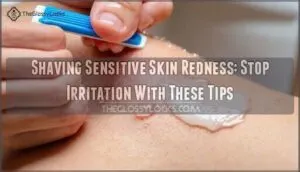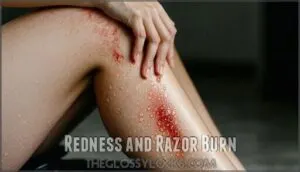This site is supported by our readers. We may earn a commission, at no cost to you, if you purchase through links.
 Shaving sensitive skin redness happens when your razor acts like sandpaper on delicate areas.
Shaving sensitive skin redness happens when your razor acts like sandpaper on delicate areas.
You’re not alone in this battle—millions face the same red, angry aftermath.
The culprits include dull blades, dry shaving, and pressing too hard.
Your skin rebels with inflammation, bumps, and that familiar burning sensation.
To calm the storm, shave with the grain using a sharp blade and quality shaving cream.
Apply gentle pressure—you’re not carving wood.
Cool water helps close pores afterward, while aloe vera soothes irritated skin.
Don’t let razor burn win this war.
Smart techniques and proper aftercare transform your shaving routine from torture to triumph.
Table Of Contents
- Key Takeaways
- Shaving Sensitive Skin
- Redness and Razor Burn
- Shaving Techniques Matter
- Sensitive Skin Care Tips
- Preventing Shaving Irritation
- Dealing With Shaving Rash
- Long-Term Skin Health
- Frequently Asked Questions (FAQs)
- How to make redness from shaving go away?
- How to deal with sensitive skin when shaving?
- What does an allergic reaction to shaving look like?
- Can you use hydrocortisone cream on shaving rash?
- How long does shaving redness typically last?
- Can certain foods worsen shaving skin sensitivity?
- Should I shave daily with sensitive skin?
- Do electric razors cause less skin irritation?
- When should I see a dermatologist for redness?
- Conclusion
Key Takeaways
- You’ll prevent redness and irritation by using sharp blades, shaving with the grain, and applying light pressure—dull razors create friction that turns your skin into an angry mess.
- You can treat razor burn immediately with cold compresses for 15-20 minutes and aloe vera gel to reduce inflammation and soothe irritated skin.
- You should prepare your skin properly by exfoliating 24-48 hours before shaving, using warm water to open pores, and applying pre-shave oil for extra protection.
- You need to moisturize immediately after shaving with fragrance-free products and avoid re-shaving irritated areas until they’ve completely healed.
Shaving Sensitive Skin
If you’ve got sensitive skin, you’re probably familiar with the redness, burning, and irritation that can follow your shaving routine.
Understanding what causes these reactions and learning proper techniques can help you achieve a smooth shave without the uncomfortable aftermath that affects nearly half of all people who remove body hair.
Causes of Redness and Irritation
Several factors trigger redness after shaving sensitive skin.
Gentle shaving isn’t just technique—it’s your skin’s best defense against irritation and long-term damage.
Dull blades create excessive friction, while dry shaving strips your skin’s natural protective barrier.
Product sensitivity from harsh chemicals amplifies skin irritation, and applying too much shaving pressure damages delicate tissue.
Shaving against hair direction pulls follicles unnaturally, and these combined factors create the perfect storm for skin redness and uncomfortable shaving irritation relief needs, due to excessive friction and harsh chemicals.
Identifying Sensitive Skin Areas
Your skin’s sensitivity isn’t the same everywhere.
Facial mapping reveals which zones need extra care during sensitive skin shaving. Understanding your irritation threshold helps prevent redness after shaving and provides effective shaving irritation relief.
Here’s how to identify your most vulnerable areas for shaving sensitive skin:
- Face and neck – Thinner skin thickness makes these areas prone to razor burn
- Underarms – Constant movement increases friction and allergic reactions risk
- Bikini line – Coarse hair and delicate skin create perfect storm for irritation
- Behind knees – Often overlooked but genetic factors make this spot extra sensitive
Importance of Gentle Shaving Techniques
Now that you’ve pinpointed your trouble spots, mastering gentle shaving techniques becomes your ticket to irritation-free skin.
Minimize irritation by applying feather-light pressure and using short, controlled strokes. Prevent redness through proper exfoliation before shaving, which removes dead skin cells that can clog your razor.
| Shaving Technique | Pressure Level | Result |
|---|---|---|
| Heavy pressure | Firm, aggressive | Red, inflamed skin |
| Medium pressure | Moderate force | Minor irritation |
| Light pressure | Gentle touch | Smooth, calm skin |
| Feather-light | Barely touching | Zero irritation |
| No pressure | Razor weight only | Perfect glide |
Soothing ingredients in your gentle products work best when paired with proper shaving techniques. Remember, your razor should glide like butter on warm toast—forcing it creates friction that leads to angry, red skin.
Redness and Razor Burn
If you’ve ever experienced that stinging, burning sensation and angry red patches after shaving, you’re dealing with razor burn.
This common skin irritation occurs when your razor blade damages hair follicles and surrounding skin, creating inflammation that can last several days without proper treatment.
Symptoms and Diagnosis
Razor burn announces itself with telltale redness and burning sensations across your freshly shaved skin.
You’ll notice irritated patches, possible swelling, and that unmistakable stinging feeling.
Most cases are self-diagnosis friendly—if symptoms appear shortly after shaving, you’ve got your answer.
However, persistent irritation lasting beyond several days or infection signs like pus warrant medical consultation for proper treatment.
Treatment Options for Razor Burn
When razor burn strikes, you’ve got several effective treatment paths.
Cold compresses immediately reduce inflammation, while hydrocortisone cream tackles stubborn redness within 48 hours.
Moisturizing balms restore your skin’s protective barrier, and antibiotic creams prevent infection if irritation worsens.
A key step is to understand the difference between razor burn and distinct razor bumps. Consider switching to a clipper alternative until healing completes—your skin needs breathing room to recover properly.
Home Remedies for Soothing Irritation
Nature’s medicine cabinet offers powerful relief for post-shave irritation.
Apply a cold compress for 15 minutes to reduce redness instantly. Aloe vera gel soothes sensitive skin with its anti-inflammatory properties.
Try an oatmeal bath to calm widespread irritation, or dab witch hazel on affected areas. Natural oils like coconut provide gentle moisture.
Dull razors increase irritation. Tea remedies using chamomile offer additional comfort.
Shaving Techniques Matter
How you shave determines whether you’ll walk away with smooth skin or angry red patches that sting for days.
Your technique makes the difference between a comfortable shave and razor burn that leaves you regretting the entire experience.
Shaving With The Grain
When you follow your hair growth direction, you’ll minimize irritation and achieve reduced redness that sensitive skin craves.
Proper technique means understanding your unique growth patterns before each shave.
- Map your hair growth direction – Run your hand across different areas to feel which way hair naturally lies
- Adjust your blade angle – Keep the razor at 30 degrees following hair’s natural path
- Focus on one direction per stroke – Resist the urge to go against the grain for closer results
Using Light Pressure and Short Strokes
Applying excessive force turns your razor into a bulldozer, scraping away precious skin layers.
Light pressure minimization protects sensitive skin from unnecessary trauma while maintaining effective hair removal.
Keep your shaving strokes short—about an inch long—for better razor control and technique refinement.
This gentle approach prevents the burning sensation that haunts post-shave mornings, especially for sensitive skin shaving enthusiasts.
For ideal results, consider pre-shave skin prep to soften the hair.
Importance of Exfoliation and Skin Preparation
Before you shave, proper skin preparation makes all the difference for sensitive skin shaving success.
Pre-shave cleansing and gentle scrubs create the foundation for irritation-free results.
Here’s your skin preparation checklist:
- Exfoliation timing: Scrub 24-48 hours before shaving
- Oil benefits: Apply pre-shave oil for protection
- Softening hair: Use warm water to open pores
- Gentle scrubs: Remove dead skin without over-scrubbing
- Clean surface: Wash with mild cleanser first
To further enhance the process, consider using natural shaving ingredients like aloe vera or coconut oil.
Sensitive Skin Care Tips
You’ll need to select the right products and ingredients to protect your sensitive skin during shaving.
The key lies in choosing gentle formulations that soothe rather than irritate, particularly those containing natural healing compounds like aloe vera.
Choosing Gentle Shaving Creams
Selecting the right shaving cream sensitive skin deserves becomes your first line of defense against irritation. Look for hypoallergenic, fragrance-free sensitive formulas that contain 30-50% natural fat content for ideal protection.
Cream ingredients like almond oil and coconut oil create protective barriers while ensuring smooth application techniques. These specialized products offer superior razor compatibility, reducing friction during each stroke.
Dermatologist-tested options eliminate harsh chemicals that trigger reactions. When you choose gentle, non-comedogenic formulations, you’re investing in better post-shave effects.
Consider exploring options for specialized shaving products online. Remember, quality sensitive skin shaving cream prevents most skin irritation before it starts, and using the right cream is a crucial step in maintaining healthy, sensitive skin, and achieving a smooth shave with gentle care and non-comedogenic products.
Using Soothing Ingredients Like Aloe Vera
Beyond cream selection, your skin craves natural healing power. Aloe vera stands as nature’s ultimate skin soother, offering anti-inflammatory properties that calm post shave redness instantly. This miracle plant doesn’t just moisturize—it actively repairs damaged skin while creating a protective barrier.
You can buy commercial soothing aftershave balm containing aloe or create DIY aloe treatments using fresh gel. For sensitive skin shaving recovery, apply pure aloe vera within minutes of finishing. When aloe isn’t available, alternatives like chamomile or green tea provide similar cooling relief for irritated skin.
- Fresh aloe gel penetrates deeper than processed products, delivering maximum healing benefits directly to irritated follicles
- DIY aloe treatments cost less than commercial products while providing pure, chemical-free relief for sensitive skin
- Timing matters most – apply aloe vera immediately after shaving when pores remain open for ideal absorption
- Layer aloe under moisturizer to lock in healing properties and create a protective barrier against environmental irritants
- Patch test new aloe products on your wrist before facial application to avoid unexpected allergic reactions
Preventing Shaving Irritation
You can prevent most shaving irritation by preparing your skin properly before you pick up the razor.
The right combination of exfoliation, sharp blades, and post-shave care creates a protective barrier that keeps redness and razor burn at bay.
Pre-Shave Preparation and Exfoliation
Nothing beats proper preparation when you’re dealing with sensitive skin.
Start with warm water to open pores, then use a gentle cleanser to remove dirt and oils.
Apply pre-shave oil for extra protection, followed by quality shaving cream.
Use a shaving brush to lift hairs and create rich lather.
Remember, exfoliation timing matters—do it 24-48 hours before shaving.
Using Sharp Razor Blades and Cleaning The Razor
Dull razor blades create friction-filled nightmares for sensitive skin.
Replace your razor blades every 5-7 shaves to maintain blade sharpness and prevent bacterial buildup.
Rinse your razor under warm water after each stroke, then store it in a dry location.
Proper razor cleaning and razor hygiene are essential for infection prevention and extending blade lifespan while protecting your delicate skin.
To further extend blade life, consider applying blade oil to maintain your razor’s effectiveness.
Applying Moisturizer and Aftershave
Your skin craves attention after shaving, so don’t leave it hanging.
Apply a fragrance-free moisturizer immediately to restore your skin’s protective barrier and lock in hydration.
Consider products for sensitive skin to avoid irritation.
Follow with a gentle aftershave containing aloe vera or chamomile for sensitive skin.
This winning product combination provides skin redness relief while preventing irritation from developing into a full-blown shaving aftercare disaster.
Dealing With Shaving Rash
When you’re dealing with red, irritated skin after shaving, you’ll want to act quickly to reduce inflammation and prevent the rash from getting worse.
The key is using cooling treatments and gentle care while avoiding anything that might cause further irritation or infection.
Identifying and Treating Shaving Rash
After shaving, rash identification becomes essential when red streaks or blotches appear on your skin.
Shaving rash differs from razor burn through its patchy appearance and intense itching.
Treatment options include avoiding further shaving until healing occurs.
Most skin irritation resolves within days, but infection prevention requires keeping the area clean and dry for ideal recovery, which is crucial for complete healing.
Using Cold Compresses and Anti-Inflammatory Creams
When razor burn strikes, your skin needs immediate relief.
Cold compresses work like magic, constricting blood vessels and reducing redness within minutes.
Anti-inflammatory creams containing hydrocortisone or aloe vera calm angry skin and speed healing.
Here’s your rescue plan:
- Apply cold compress for 10-15 minutes immediately after noticing irritation
- Choose fragrance-free anti-inflammatory creams to avoid further skin inflammation
- Gently pat cream onto affected areas—don’t rub vigorously
- Use witch hazel or calendula for natural skin soothing properties
- Reapply treatment every few hours for severe irritation relief
Consider using a specialized compress product for ideal results.
Avoiding Further Irritation and Infection
Once you’ve treated the initial irritation, protecting your healing skin becomes essential.
Never re-shave over existing redness—you’ll only make things worse. Keep the area clean and watch for signs of infection like pus or spreading inflammation.
| Do This | Avoid This |
|---|---|
| Apply antiseptic aftercare products | Re-shaving irritated areas |
| Maintain cleanliness importance daily | Tight clothing causing friction |
| Use antiinflammatory treatments | Alcohol-based products |
| Monitor for infection signs | Scratching or picking |
Long-Term Skin Health
You’ll protect your skin‘s health over time by consistently using gentle shaving techniques that reduce long-term damage and irritation.
Creating a routine with natural ingredients and proper preparation helps maintain your skin’s natural barrier, preventing chronic sensitivity that can develop from years of harsh shaving practices.
Maintaining Healthy Skin Through Gentle Shaving
Consistent gentle practices create lasting results for your skin’s health.
Hydration importance can’t be overstated—moisturize daily to maintain your skin’s protective barrier.
Blade maintenance prevents unnecessary trauma, while proper technique refinement reduces irritation over time.
Post-shave care and thoughtful product selection build resilience.
These shaving tips sensitive skin needs will transform your routine from damaging to nurturing with proper technique.
Using Natural Ingredients and Avoiding Harsh Chemicals
Your sensitive skin deserves gentler treatment than harsh commercial products provide.
Natural alternatives like aloe vera and tea tree oil offer powerful healing without chemical irritants that trigger skin irritation.
DIY remedies using coconut oil or oatmeal create effective, sustainable shaving solutions.
Research ingredients before purchasing—avoid alcohol, sulfates, and artificial fragrances.
Natural ingredients work better for long-term skin health.
Considering Alternative Hair Removal Methods
When shaving consistently causes irritation, exploring alternatives can save your skin.
Consider these gentle options for sensitive skin care:
- Laser Hair Removal offers permanent reduction with minimal surface damage
- Threading and Sugaring remove hair naturally without harsh chemicals
- Electric shaver provides closer cuts than traditional razors
Depilatory Creams work for larger areas, while Electrolysis Effectiveness varies by individual needs.
For a permanent solution, consider laser hair removal to target follicles.
Frequently Asked Questions (FAQs)
How to make redness from shaving go away?
Apply a cold compress for 15-20 minutes to reduce inflammation.
Use aloe vera gel or fragrance-free moisturizer to soothe irritated skin.
Avoid shaving the area until redness completely disappears to prevent further irritation.
How to deal with sensitive skin when shaving?
Like traversing a minefield, you’ll need gentle precision.
Use single-blade razors, shave with the grain, apply cool compresses afterward, and choose fragrance-free products.
Your skin’s delicate nature demands respect, not force.
What does an allergic reaction to shaving look like?
Red, inflamed skin appears immediately after shaving, often with raised bumps, intense itching, or burning sensations.
You’ll notice widespread irritation beyond normal razor burn, potentially including hives or swelling around shaved areas, which can be characterized by intense itching.
Can you use hydrocortisone cream on shaving rash?
When your skin feels like it’s on fire after shaving, hydrocortisone cream acts like a firefighter.
Yes, you can use it on shaving rash – it reduces inflammation and soothes irritation effectively.
How long does shaving redness typically last?
Most shaving redness disappears within 2-3 days as your skin naturally heals.
However, if you’ve really irritated the area or have sensitive skin, it might stick around for up to a week.
Can certain foods worsen shaving skin sensitivity?
Your diet can influence skin sensitivity, but it’s not a major factor in shaving irritation.
Spicy foods, alcohol, and high-sugar items might increase inflammation slightly, making already sensitive skin more reactive to razor friction, which can be a concern for those with sensitive skin.
Should I shave daily with sensitive skin?
About 60% of people experience skin sensitivity during hair removal.
You shouldn’t shave daily with sensitive skin – give your skin 48-72 hours between sessions to recover and prevent chronic irritation that worsens over time.
Do electric razors cause less skin irritation?
Electric razors typically cause less irritation than traditional blades because they don’t cut as close to your skin.
You’ll experience reduced friction and fewer nicks, making them gentler for sensitive skin types.
When should I see a dermatologist for redness?
Red flags wave when your skin’s angry rebellion lasts beyond three days, shows pus-filled bumps, or spreads like wildfire.
You’ll need professional backup if home remedies fail or infections take hold, which can be a clear indication that the situation is more serious than initially thought.
Conclusion
Ironically, the most sensitive part of shaving sensitive skin redness isn’t your skin—it’s your technique.
You’ve learned that sharp blades, proper preparation, and gentle pressure make all the difference.
Remember to shave with the grain, use quality products, and never rush the process.
Your skin will thank you for treating it with care rather than aggression, and these simple changes transform your daily routine from a painful chore into a comfortable experience you’ll actually enjoy.
- https://adamgroomingatelier.com/journal/meet-the-barber-sait-koca
- https://www.pexels.com/photo/woman-in-bathtub-with-water-4156336/
- https://www.dermapproach.com/how-regular-shaving-can-damage-mens-skin-and-what-you-can-do-about-it/
- https://my.clevelandclinic.org/health/diseases/23583-razor-burn
- https://health.clevelandclinic.org/want-a-smooth-safe-shave-every-time-try-these-10-tips













